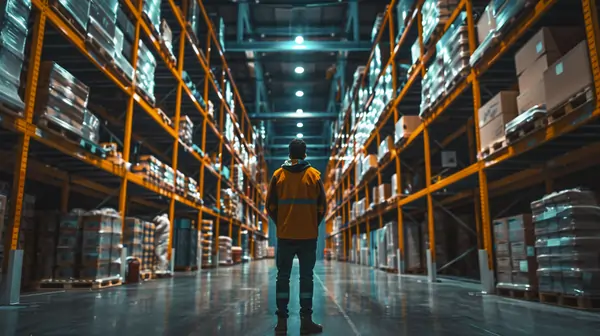In 2025, amid a rapidly changing global trade landscape, importers, supply chain managers, and legislators are all paying close attention to bonded warehouses. With rising tariffs and tighter customs rules, businesses are searching for new solutions to safeguard margins, reduce upfront costs, and maintain flexible inventory management. A popular alternative that is gaining traction is the effective use of warehouse facilities, which allow commodities to be stored without immediate payment of import charges.

According to U.S. Customs and Border Protection (CBP), goods stored in bonded warehouses can remain duty-free for up to five years, as long as they are either exported or released into domestic commerce with the necessary duties paid. This technique provides enormous financial and operational leverage to organizations, particularly in turbulent trading environments.
Bonded warehouses are not a new concept; they have been around for decades, but their importance has grown in 2025 as trade tensions and logistical methods have evolved. Unlike conventional storage facilities, warehouses are strictly regulated zones overseen by customs agents. Importers can defer duties, repackage or assemble products, and even re-export them without paying US duties. This strategy allows for cash flow flexibility while also protecting enterprises from policy shocks.
In light of new tariffs placed on various imports in early 2025 such as the 10% duties on select Chinese and European goods bonded warehouses are experiencing increased applications. Reuters reported in May 2025 that "importers are racing to turn U.S. Warehouses into tariff-free zones," emphasizing a 38% increase in applications for customs-bonded status in key commercial hubs such as Los Angeles and Houston.
Understanding the difference between bonded warehouses and duty paid warehouse systems is critical. Importers in a duty-paid warehouse must pay duties as soon as the commodities are received, even before they are sold or distributed. Warehouses, on the other hand, have a different business model than duty-paid warehouse businesses. Bonded options postpone obligations till the date of domestic release.
This flexibility in bonded warehouse and duty paid warehouse operations allows for better financial planning, particularly for seasonal items, renamed products, or those awaiting further distribution instructions. Controlled inventory exposure also allows businesses to decrease risk while increasing ROI.
Operating or utilizing a warehouse comes with a list of bonded warehouses requirements. Companies must apply to the CBP and meet regulatory criteria including physical security standards, inventory controls, fire safety compliance, and bonded insurance. Approved sites must ensure full transparency and seamless integration with customs systems.
The standard bonded warehouses requirements include:
Failure to observe warehouse requirements may result in license revocation, penalties, or the denial of duty deferment rights. As a result, the model is strongly dependent on strict compliance.
Successful operation of bonded storage hinges on robust warehouses management. Since customs oversight is continuous, inventory visibility, digital tracking, and staff training are crucial to keeping warehouses running smoothly. This applies whether businesses run their own warehouse or partner with third-party logistics providers.
Moreover, warehouses management practices must prioritize automation and regulatory data integration. With real-time inventory audits and import/export documentation, companies can reduce clearance delays and maintain operational efficiency. In fact, poorly managed warehouses management can undermine the entire value proposition of bonded warehousing.
According to a recent poll conducted by the Warehousing Education and Research Council (WERC), 74% of bonded warehouse owners expect to modernize their warehouse management systems by 2025 to improve customs integration and reduce human error. Importers, particularly those new to bonded storage, are encouraged to invest in professional warehouse management services.
This year's most important warehouse trends are driven by technological optimization, sustainability, and risk management. Three major warehouse trends are altering operations within bonded facilities:
According to Acumen Research and Consulting, the global Warehouse Automation Market is estimated to reach USD 64,639 Million by 2030, transforming how warehouses are handled in bonded facilities. Automated approaches contribute to faster customs clearance and more precise inventory management.
In bonded settings, the Warehouse Automation Market tools enable RFID tracking, auto-sorting, and customs pre-alert systems features that drastically improve throughput and compliance.
The Warehouse Automation Market also supports remote warehouses bonded solutions where monitoring and management can happen via cloud platforms, a feature particularly useful in cross-border trade zones.
In 2025, bonded warehouses will account for more than 17% of U.S. import storage, up from 11% in 2020. According to CBP data, bonded storage climbed by 29% year on year as a result of the new tariff rounds.
Warehouses near key ports like Savannah, Long Beach, and New York are running at 92% capacity. In parallel, customs wait times have reduced by 26% due to improved warehouses management technologies.
This surge demonstrates the growing importance of warehouses bonded operations in global logistics planning, particularly for electronics, textiles, and auto parts.
The revitalization of the bonded warehouses concept marks a strategic shift in global supply chain operations. With increased geopolitical tensions and economic uncertainty, bonded warehouses are more than just storage solutions; they are tools for financial optimization and trade resilience.
Businesses who grasp the differences between bonded warehouses and duty-paid warehouses, comply with warehouse laws, implement innovative warehouse management techniques, and embrace future warehouse trends will be best positioned for success.
As the Warehouse Automation Market matures, bonded warehouses will only becoming smarter, more efficient, and more important to international trade. Bonded warehouses are a smart and forward-thinking option for importers looking to avoid tariffs and supply chain issues in 2025.